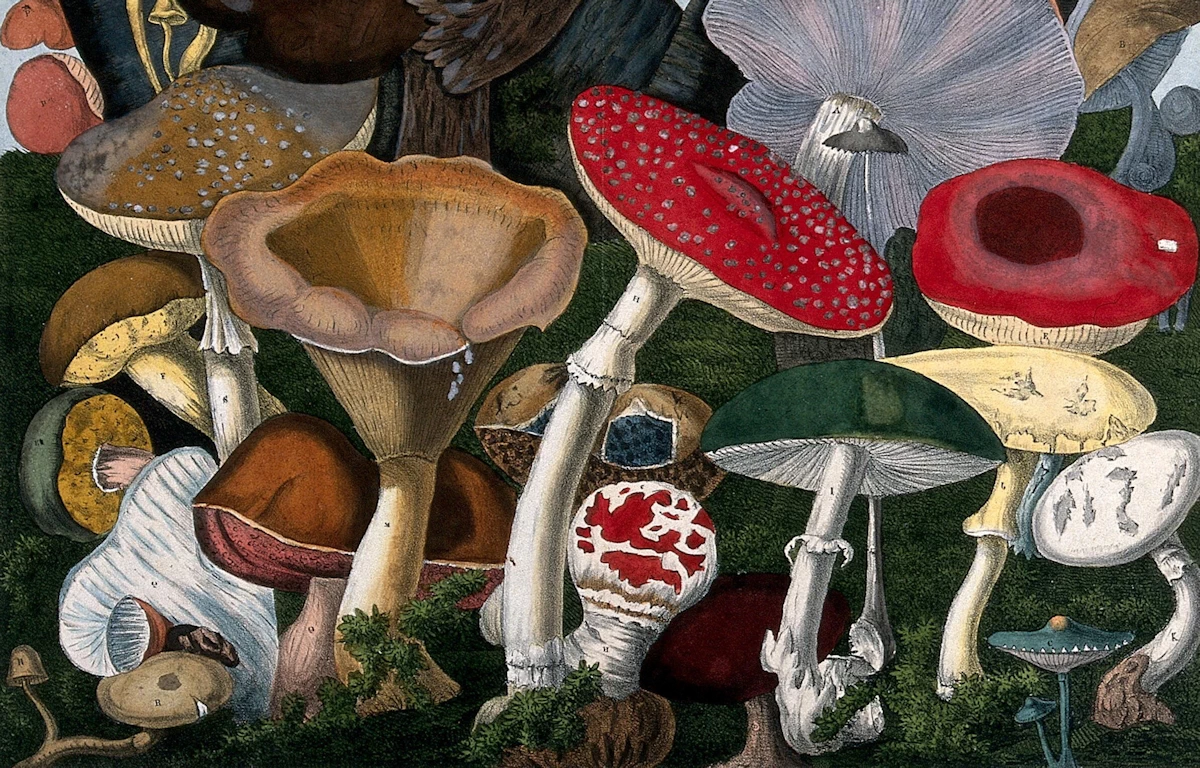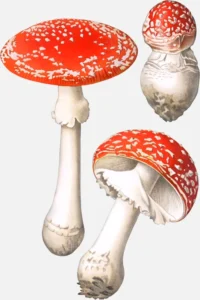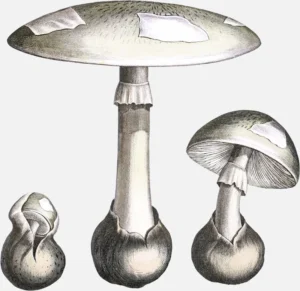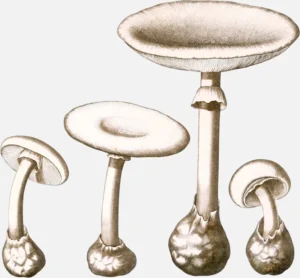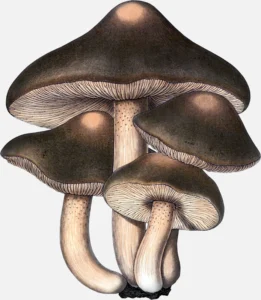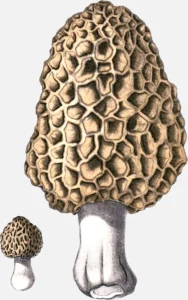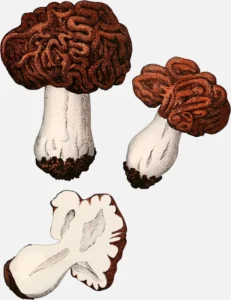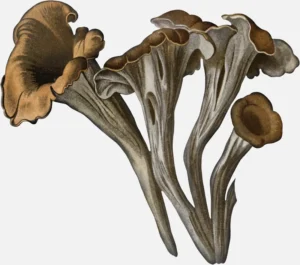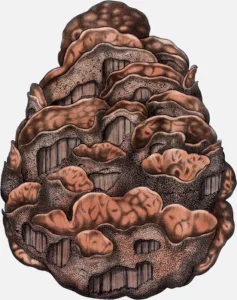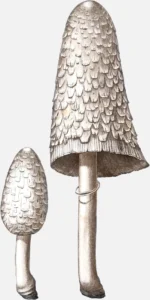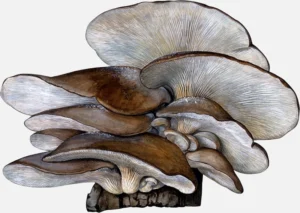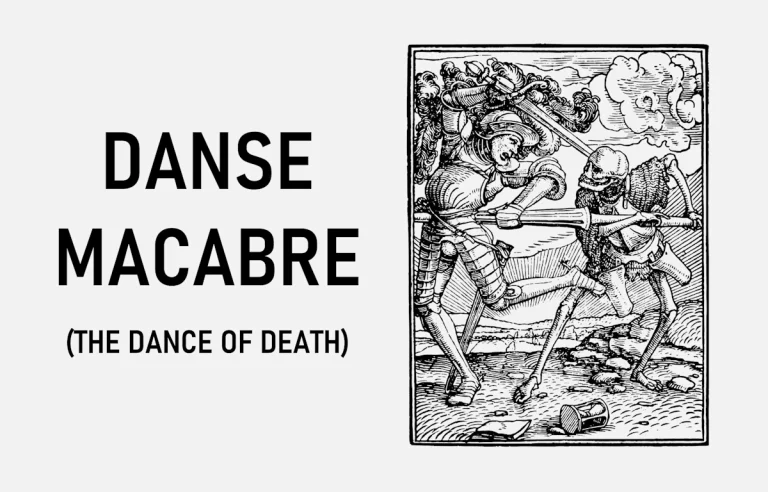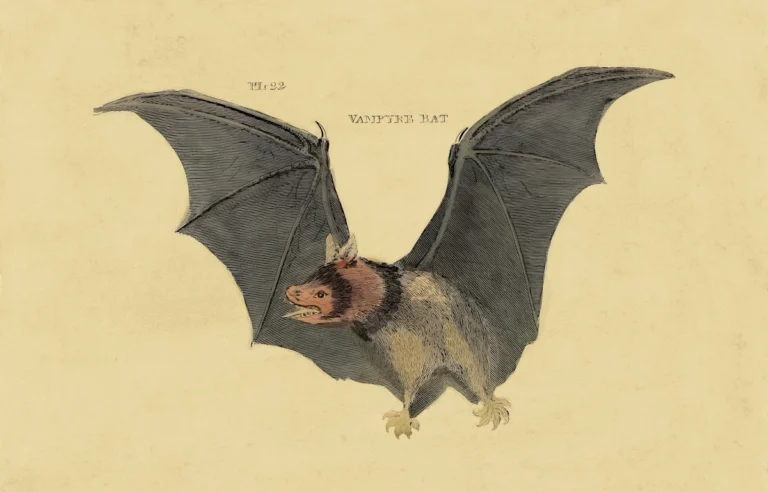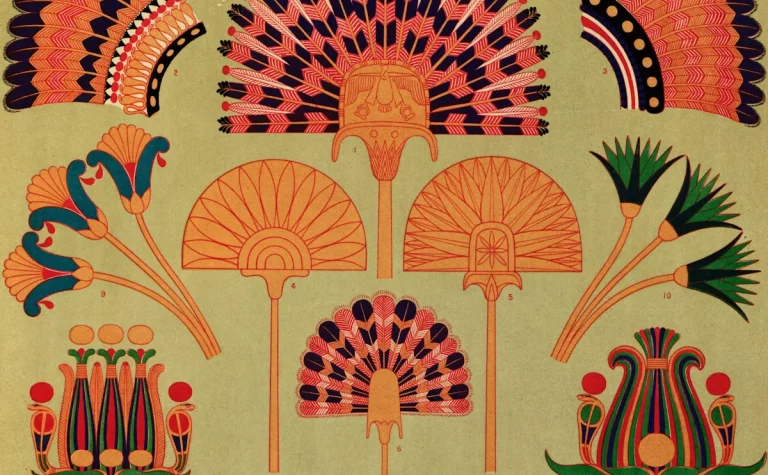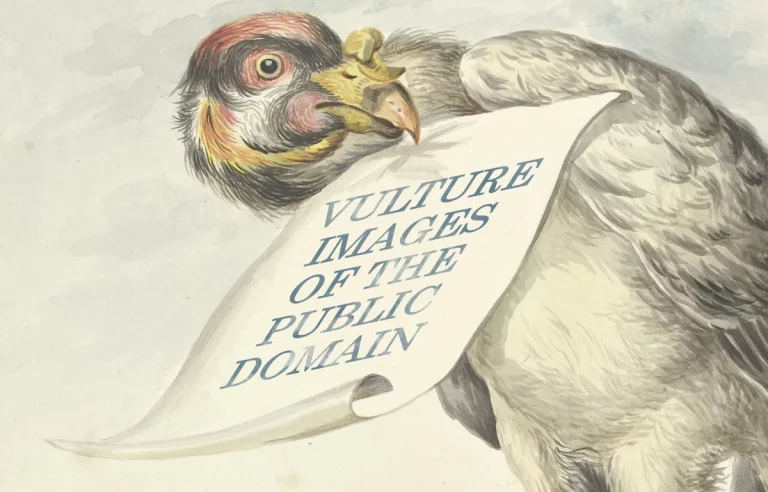Exploring the Quirky World of Mushrooms Through Vintage Illustrations
In our journey of exploring the quirky and captivating world of vintage mushroom illustrations, we’ve uncovered some of the most unique and bizarre fungi that nature has to offer. Mushrooms aren’t just those little toppings on pizza; they’re an entire universe full of history, intrigue, and some serious weirdness. From the iconic to the dangerous, fungi have played a part in everything from shamanic rituals to modern cuisine. Let’s embark on a whimsical walk through the forest and dive into the fascinating stories behind ten captivating mushrooms that we’ve uncovered. get acquainted with ten of the most captivating mushrooms we’ve uncovered.
1. Amanita muscaria (Fly Agaric)
We begin with a classic: Amanita muscaria, commonly known as the Fly Agaric. Even if you’ve never heard the name, you’ve definitely seen this mushroom before. It’s the one with the bright red cap covered in white spots, a fungi straight out of fairy tales, cartoons, and fantasy worlds. Its appearance alone makes it one of the most recognizable mushrooms in the world. But while it may look charming, this mushroom packs quite a punch.
The Fly Agaric is hallucinogenic and toxic, and its use in ancient cultures is well-documented. In Northern Europe, the Sámi people would consume this mushroom during shamanic rituals, or even drink the urine of reindeer that had eaten it. They believed it could take them on spiritual journeys, with some going so far as to claim that the Fly Agaric might be the origin of the story of Santa’s flying reindeer. Whether or not that’s true, this mushroom is certainly an eye-opener, and it has been fascinating people for centuries.
2. Amanita phalloides (Death Cap)
If the Fly Agaric is the mischievous trickster of the mushroom world, then the Amanita phalloides, or Death Cap, is its grim reaper. This mushroom doesn’t look particularly dangerous—its pale, innocent-looking appearance could easily lead someone to mistake it for a regular, harmless variety. But don’t be fooled; the Death Cap is one of the most lethal mushrooms in the world.
This mushroom contains a deadly toxin called alpha-amanitin, which attacks your liver and can cause death within days. What’s particularly scary about the Death Cap is that symptoms often don’t appear until it’s too late. People may feel perfectly fine after eating it, only to experience fatal organ failure days later. So, if you’re ever out foraging, be very cautious about what you pick—this mushroom’s innocent looks are seriously deceptive.
3. Amanita verna (Destroying Angel)
As if one deadly mushroom wasn’t enough, meet Amanita verna, or the Destroying Angel. Like the Death Cap, this mushroom is a member of the Amanita family, and it’s equally lethal. What makes the Destroying Angel so deceptive is its beauty—its pure white cap and gills give it an almost angelic appearance, which might explain its ominous name.
But don’t be fooled by its elegant look. The Destroying Angel is just as toxic as the Death Cap, containing deadly toxins that can cause fatal liver and kidney damage. One wrong bite, and it could be your last. French mycologist Jean Bulliard first illustrated this mushroom in the 18th century, and ever since then, it’s served as a chilling reminder of the deadly power lurking in the natural world.
4. Lyophyllum decastes (Fried Chicken Mushroom)
Not all mushrooms are dangerous, though. Let’s take a break from the deadly Amanitas and meet Lyophyllum decastes, also known as the Fried Chicken Mushroom. Now, despite its name, this mushroom doesn’t actually taste like fried chicken—sorry to disappoint! It’s an edible variety with a slightly radish-like flavor, and while it’s not exactly a gourmet delight, it’s a quirky addition to the world of foraging.
This mushroom grows in clusters across North America, and its peculiar appearance makes it a fun find. However, it’s not particularly sought after by chefs. In fact, some people report digestive discomfort after eating it, so it might be best to leave this one to the mushroom experts. Still, with a name like Fried Chicken Mushroom, how could we not include it in our list?
5. Morchella (Morel Mushrooms)
On the other end of the culinary spectrum, we have the famous morels, belonging to the Morchella genus. Morel mushrooms are considered the crown jewels of the mushroom kingdom and are highly prized by chefs and food enthusiasts. With their unique honeycomb-like appearance and earthy, rich flavor, they’re the caviar of the fungi world.
Finding morels in the wild is no easy task, which only adds to their allure. These mushrooms are rare, and their scarcity makes them even more valuable. But there’s good news for mushroom lovers—Danish researchers have recently discovered a way to cultivate morels indoors, which could make these expensive fungi more accessible in the future. Until then, morels will continue to be a prized find for seasoned foragers and culinary connoisseurs alike.
6. Gyromitra esculenta (False Morel)
Speaking of morels, let’s talk about their dangerous doppelganger—the Gyromitra esculenta, also known as the False Morel. With its wrinkled, brain-like appearance, this mushroom is often confused with true morels. However, mistaking a False Morel for the real thing can have serious consequences.
The False Morel contains a toxin called gyromitrin, which is highly poisonous and can even be fatal if consumed raw. Despite this, some people in the Great Lakes region still consider it a delicacy. These daring mushroom hunters carefully prepare it by boiling and drying it to remove the toxins. It’s a risky process, but for those who know how to handle it, the reward is a unique culinary experience.
7. Craterellus cornucopioides (Horn of Plenty)
Let’s switch gears from the dangerous to the delicious with Craterellus cornucopioides, commonly known as the Horn of Plenty or the Trumpet of the Dead. Despite its somewhat spooky names, this mushroom is actually a prized edible variety. Found in North America, Europe, and East Asia, the Horn of Plenty has a rich, nutty, and slightly smoky flavor that some say rivals the taste of black truffles.
This mushroom can be a bit tricky to spot in the wild due to its dark color, which allows it to blend into the forest floor. But if you’re lucky enough to find it, you’re in for a treat. Its versatility in the kitchen makes it a favorite among gourmet chefs, and it’s used in everything from soups to sauces to pasta dishes. The Horn of Plenty is proof that sometimes, the best things come in small, dark packages.
8. Heterobasidion annosum (Root Rot Fungus)
Not all mushrooms are friendly, though. Some can be downright destructive, like Heterobasidion annosum, also known as the Root Rot Fungus. This mushroom is a tree’s worst nightmare, responsible for killing millions of trees every year. It’s one of the most destructive forest pathogens in the Northern Hemisphere and causes massive economic and ecological damage.
The Root Rot Fungus spreads through root contact and airborne spores, and once it infects a tree, there’s not much that can be done to stop it. It causes root rot, weakening the tree’s structure and eventually killing it. The economic impact of this fungus is staggering, with damage costs running into billions each year. It’s a sobering reminder that not all mushrooms are here to delight our senses—some are capable of wreaking havoc on entire ecosystems.
9. Coprinus comatus (Shaggy Ink Cap)
Let’s lighten things up again with a truly unique mushroom: Coprinus comatus, better known as the Shaggy Ink Cap. This mushroom looks like it came straight out of a Tim Burton movie, with its tall, white, shaggy appearance. But the real magic happens when it starts to age—it dissolves into an inky black liquid, which is where it gets its name.
The Shaggy Ink Cap is actually edible when young, and its flavor is mild and slightly nutty. However, you have to act fast if you want to enjoy it—wait too long, and you’ll end up with a puddle of black goo instead of a tasty treat. This mushroom’s transformation is truly one of nature’s oddities, and its quirky appearance has made it a favorite among mushroom enthusiasts.
10. Pleurotus ostreatus (Oyster Mushroom)
Last but certainly not least, we have Pleurotus ostreatus, or the Oyster Mushroom. This mushroom is a bit of a superstar in the fungi world, known for both its culinary versatility and its unique ability to hunt. Yes, you read that right—this mushroom is one of the few carnivorous fungi out there.
The Oyster Mushroom’s mycelium (the root-like structure of fungi) can trap and digest tiny nematodes, worm-like creatures that provide extra nutrients for the mushroom. Despite this somewhat gruesome ability, the Oyster Mushroom is a staple in kitchens worldwide, particularly in Asian cuisine. Its delicate flavor and meaty texture make it perfect for stir-fries, soups, and sautéed dishes. It’s a mushroom with both brains and brawn, and it’s one that’s earned its place in the culinary world.
And there you have it—a deep dive into some of the most intriguing mushrooms on the planet, all brought to life through the magic of vintage illustrations. From the deadly to the delicious, mushrooms continue to captivate us with their strange beauty and fascinating stories. Whether you’re a seasoned forager or just someone who enjoys a good mushroom risotto, there’s always more to discover in the weird and wonderful world of fungi. 🍄


